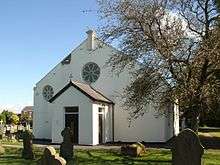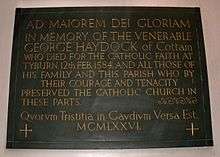George Haydock
George Haydock (born 1556; executed at Tyburn, 12 February 1584) was an English Roman Catholic priest. He is a Catholic martyr, beatified in 1987.
Life
He was the youngest son of Evan Haydock of Cottam Hall near Preston, Lancashire, and Helen, daughter of William Westby of Mowbreck Hall, Lancashire. He was educated at Douai College and the English Colleges at Douai and Rome. He was ordained priest (apparently at Reims), 21 December 1581.[1]

He arrived in England in mid-January 1582 and was arrested around 4 February while visiting an old acquaintance named Hawkinson. In the five years since they'd last met, Hawkinson, a former Catholic, had apostatized and having then encountered Haydock in London, informed the priest hunters Norton and Sledd.[2]
Arrested in London soon after landing in England, he spent a year and three months in confinement in the Tower of London, suffering from a malarial fever he first contracted in the early summer of 1581 when visiting the seven churches of Rome. About May, 1583, though he remained in the Tower, his imprisonment was relaxed to "free custody", and he was able to administer the Sacraments to his fellow-prisoners. During the first period of his captivity he was accustomed to decorate his cell with the name and arms of the pope scratched or drawn in charcoal on the door or walls, and through his career his devotion to the papacy amounted to a passion.[1]
On 16 January 1584, he and other priests imprisoned in the Tower were examined at the Guildhall by the recorder touching their beliefs. He frankly confessed, with reluctance, that he was eventually obliged to declare that the queen was a heretic, and so seal his fate.[1]

On 5 February 1584, he was indicted with James Fenn, a Somersetshire man, formerly fellow of Corpus Christi College, Oxford, William Deane who had been ordained priest the same day as himself, and six other priests, for having conspired against the queen at Reims, 23 September 1581, agreeing to come to England, 1 October, and setting out for England, 1 November. In point of fact he arrived at Reims on 1 November 1581.
On the same 5 February two further indictments were brought, the one against Thomas Hemerford, a Dorsetshire man, sometime scholar of St John's College, Oxford, the other against John Munden, a Dorsetshire man, sometime fellow of New College, Oxford, John Nutter, a Lancashire man, sometime scholar of St John's College, Cambridge, and two other priests. The next day, St Dorothy's Day, Haydock, Fenn, Hemerford, Munden, and Nutter were brought to the bar and pleaded not guilty.
Haydock had for a long time shown a great devotion to St Dorothy, and was accustomed to commit himself and his actions to her daily protection. It may be that he first entered the college at Douai on that day in 1574-5, but this is uncertain. The Concertatio Ecclesiae says he was arrested on this day in 1581-2, but the Tower bills state that he was committed to the Tower on the 5th, in which case he was arrested on the 4th. On Friday the 7th all five were found guilty, and sentenced to death. The other four were committed in shackles to "the pit" in the Tower. Haydock, perhaps in case he should die by a natural death, was sent back to his old quarters.
Thomas Hemerford
Thomas Hemerford was born about 1553 in Dorsetshire, and studied at St John's College, Oxford. On June 30, 1575 he obtained a Bachelor of Civil Law degree from Hart Hall.[3] In October 1580 he entered the English College at Rome. Hemerford is described as "a short man with a dark beard, severe of look but of a sweet disposition".[4]
Ordained in Rheims in March 1583, he arrived in Hampshire in June. He was obliged o stay in a village while the blacksmith replaced a shoe on his horse, and a passerby denounced him as the priest who had preached in he barn. He was imprisoned at Winchester and then brought to the Marshalsea where he was indicted for conspiring with John Mundyn for the death of the Queen.[5] From there he was committed to the Tower. Hemerford was tried and found guilty, despite a defective indictment, on February 7, 1584.
John Mundyn
John Mundyn was born in the Manor of Coltley in Dorset. He entered Winchester College in 1555 at the age of twelve, and the attended New College, Oxford, but was deprived for failing to communicate since the accession of Elizabeth. He then became for a time a schoolmaster in Dorset. In 1580 he left to study civil law at Douai, then at Rheims. In October 1581 he entered the English College in Rome. By June 1582 he was back at Rheims and left for the English Mission the following August.[6]
In February 1583, while riding from Winchester to London, he happened on Hounslow Heath a magistrate from Dorset who recognized him. Mundyn was then arrested. Walsingham was so dissatisfied with Mundyn's answers when questioned that he gave the priest a blow to the face that affected Mundyn's hearing for several days.[7] Mundyn was remanded to the Broad Arrow Tower at the Tower of London. Mundyn was tried for conspiring against the Queen and condemned on February 6, 1584.
James Fenn and Thomas Hemerford were beatified by Pope Pius XI in December 1929. Their feast day is February 12.[8]
Death
Early on Wednesday the 12th the five priests were drawn to Tyburn on hurdles; Haydock, being probably the youngest and certainly the weakest in health, was the first to suffer. All were hung, cut down before dead, and dismembered alive.[9]
See also
Further reading
- A biography of James Fenn from Holy Ghost Catholic Church, Yeovil
References
- 1 2 3 Wainewright, John. "Ven. George Haydock." The Catholic Encyclopedia Vol. 7. New York: Robert Appleton Company, 1910. 25 March 2016
- ↑ Wainewright, John Bannerman. "Venerable George Haydock", Lives of the English Martyrs, (Edwin H. Burton and J. H. Pollen eds.), London. Longmans, Green and Co., 1914
- ↑ Pollen, John Hungerford. Acts of the English Martyrs, London. Burns and Oates Ltd. 1891
- ↑ Burton and Pollen, p.72.
- ↑ Pollen, John Hungerford. "Indictment and Judgment of Thomas Hemerford", Unpublished Documents Relating to the English Martyrs, London. Catholic Record Society, 1908
- ↑ Burton and Pollen, p.95.
- ↑ Burton and Pollen, p.98.
- ↑ Bunson, Matthew et al., "Thomas Hemerford", Our Sunday Visitor's Encyclopedia of Saints, OSV Publishing, 2003 ISBN 9781931709750
- ↑ Burton and Pollen, p.75.
- Attribution
 This article incorporates text from a publication now in the public domain: Herbermann, Charles, ed. (1913). "Ven. George Haydock". Catholic Encyclopedia. New York: Robert Appleton. The entry, written by John Bannerman Wainewright, cites:
This article incorporates text from a publication now in the public domain: Herbermann, Charles, ed. (1913). "Ven. George Haydock". Catholic Encyclopedia. New York: Robert Appleton. The entry, written by John Bannerman Wainewright, cites:
- Joseph Gillow, Bibl. Dict. Eng. Cath., III, 202; cf. III, 265; V, 142, 201;
- Catholic Record Society, publications (London, 1905- ), II, V, passim, III, 12-15; IV, 74;
- Henry Foley, Records Eng. Prov. S.J., VI (London, 1875–1883), 74, 103;
- John B. Wainewright in Catholic Truth Society's pamphlets: George Haydock; James Fenn; John Nutter; Two English Martyrs;
- John Hungerford Pollen, Acts of English Martyrs (London, 1891), 252, 253, 304.